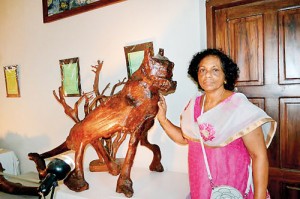Crocs and monkeys leap out of driftwood
View(s):What started off as a hobby for Raji Punnoose is now a museum that draws visitors from near and far, says Aanya Wipulasena in Kerala
It takes a beautiful mind to spot creativity in what would otherwise be discarded at first glance as something washed up and useless- like a piece of driftwood. It takes passion and dedication to create from driftwood, objects of art that can fascinate people from faraway countries.
Raji Punnoose who lives in Kerala, India, is someone who transforms the ordinary and the mundane into something unorthodox and quirky. For years, her hobby has been to collect driftwood and transform it into a leaping lioness, a crocodile basking in the sun, a blooming rose- or even a likeness of Hanuman or Jesus Christ.
When she began her hobby her aim was to adorn her house but today she has a collection of 135 driftwood pieces that are not in her garden or living room, but in a museum. It is a popular tourist attraction, that the tourism site in Kerala “www.godsownplaces.com” calls “one of its kind in India” for this is the only driftwood museum in the country.
Located in Kottayam district, four km from the Kumarakom Bird Sanctuary, Bay Island Driftwood Museum is one of the most visited tourist

A woman’s touch: Raji and her driftwood creations
destinations in Kerala.
It all started in the 1980s when Raji, a postgraduate teacher and mother of two, accompanied her engineer husband to the Andaman and Nicobar Islands, where he worked till his retirement in the 2000s. She had little to do but wander through the islands and especially the beaches. One day while strolling on the beach, her usual pastime, a washed-up piece of wood caught her eye. She knew the piece of driftwood would add to the look of her garden.
“Please stand there, next to that table and take a look at this black monkey which is ready to jump,” she said, tapping wood with a steel rod to create a clanging sound. With the steel rod in one hand, an electric lamp in the other and a side pouch hanging from her shoulder, she bade us take a closer look at her first driftwood creation.
She said when she saw the driftwood on the beach, it vaguely resembled a monkey but it took hours of chiselling and carving to take its final shape and make others also see the monkey shape in the driftwood. Soon she became a regular at the beach side or by a crocodile-infested stream.
“Of course it was not an easy journey,” she recalled. “These pieces of driftwood are unbelievably heavy and very hard. The islands are not a safe place in which to wander, too. I always had a local resident with me to help me out in case of danger.”
And to remind her of the danger is a piece of driftwood that she recovered painstakingly, and which she converted into her most treasured creation: a realistic looking crocodile. With sharp teeth jutting out of its mouth, scales down its back and a long tail the carving looked more than real.
“It was not an easy task at all,” she said.” The wood was stuck amidst roots and I had to get it out somehow.” Stubbornly she wrestled the wood from the mud while a local resident stood lookout as man-eater crocodiles were known to lurk in the area. Finally after 45 days, she had her piece of wood in hand.
“Look how majestic it is. Look at nature’s splendour,” she said gazing adoringly at the end product, a perfect mirror image of a crocodile.
After her husband’s retirement, Raji bought some land in Kumarakom, near Kottayam, and took a bank loan for the building. In the early 2000s, she opened her own museum displaying her driftwood treasures- her collection of 25 years.
Her museum has drawn many tourists from all over India and the world and it was mentioned in ‘The Rough Guides and the Lonely Planet”, in a review that said, “It is worth stopping by the museum.”
The Museum visiting hours are from 10 a.m. to 5 p.m., Tuesday to Saturday, and 11.30 a.m. to 5 p.m. on Sundays. Entry per head is Indian Rs. 50.


